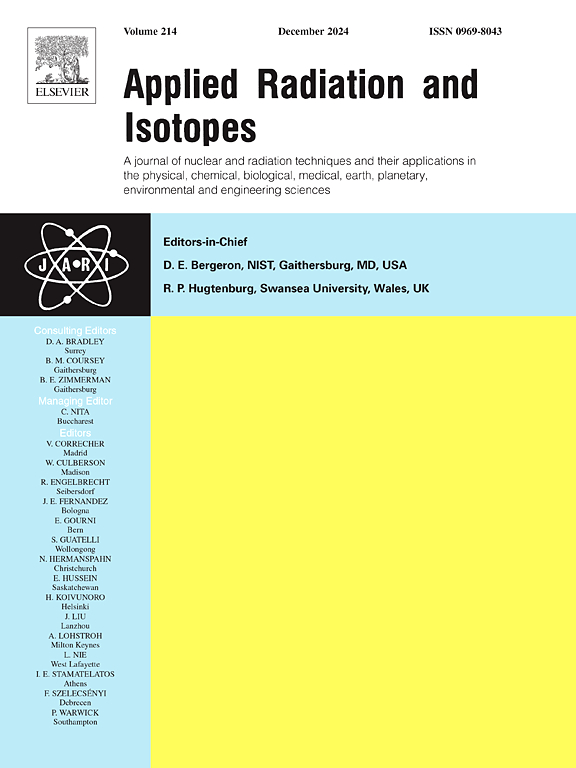对接受前列腺放射治疗的患者进行器官剂量和相关继发性癌症风险估计的蒙特卡洛研究:阿尔及利亚人口研究
IF 1.6
3区 工程技术
Q3 CHEMISTRY, INORGANIC & NUCLEAR
引用次数: 0
摘要
本研究旨在评估阿尔及利亚前列腺癌患者在接受三维适形放射治疗(3D-CRT)期间的器官剂量以及与二次辐射(光子和中子)照射相关的癌症风险。为此,我们结合混合全身模型,对 LINAC 进行了详细的几何蒙特卡罗(MC)建模。计算了场内外患者器官的二次辐射剂量。利用电离辐射生物效应 VII(BEIR VII)风险模型,并考虑到阿尔及利亚接受治疗的患者年龄的照射年龄范围,所获得的剂量被用于估算场外器官癌症发病的终生可归属风险(LARs)。生存信息和基线癌症风险基于阿尔及利亚人口的相关统计数据。结果显示,二次辐射当量剂量主要取决于器官与治疗部位的距离。小肠和眼晶状体的等效剂量最高为 5.77 mSv/Gy,最低为 0.24 mSv/Gy。等效剂量随暴露年龄的增加而降低,每 10 万人的最高估计值出现在暴露年龄为 35 岁的人群中(结肠为 88,肠道为 15)。相反,70 岁时的风险最低,特别是肋骨和腿骨的风险值为(0)。目前的研究有助于建立阿尔及利亚前列腺癌 3D-CRT 放疗诱发继发性癌症发病率的数据库。本文章由计算机程序翻译,如有差异,请以英文原文为准。
Monte Carlo study of organ doses and related secondary cancer risk estimations for patients undergoing prostate radiotherapy: Algerian population-based study
The present study aimed to assess organ doses and the associated cancer risks related to secondary radiation (photons and neutrons) exposure during 3D Conformational Radiotherapy (3D-CRT) for patients with prostate cancer in Algeria. To this purpose, a detailed geometric Monte Carlo (MC) modeling of the LINAC, combined with a hybrid whole-body phantom was carried out. The secondary radiation doses were calculated in patient's organs, both within and outside the field. The obtained doses were used to estimate the Lifetime Attributable Risks (LARs) for cancer incidence for out of field organs, using the Biological Effects of Ionizing Radiation VII (BEIR VII) risk model, considering the exposure age range according to the age of the treated patients in Algeria. The survival information and baseline cancer risks were based on relevant statistics for the Algerian population. The results revealed that secondary radiation equivalent doses mostly depend on the distance of organs from the treated volume. The highest and lowest equivalent doses of 5.77 mSv/Gy and 0.24 mSv/Gy were recorded in the small intestine and ocular lens, respectively. LARs decreased as the age of exposure increased, with the highest estimated value per 100,000 individuals identified at a 35-year exposure age (88 for the colon and 15 for the intestine). Conversely, the lowest risks were found at 70 years of age, specifically in rib bone and leg bone with value of (0). The current research could contribute to establishing a database concerning the incidence of secondary cancers induced by radiotherapy during 3D-CRT for prostate cancer in Algeria.
求助全文
通过发布文献求助,成功后即可免费获取论文全文。
去求助
来源期刊

Applied Radiation and Isotopes
工程技术-核科学技术
CiteScore
3.00
自引率
12.50%
发文量
406
审稿时长
13.5 months
期刊介绍:
Applied Radiation and Isotopes provides a high quality medium for the publication of substantial, original and scientific and technological papers on the development and peaceful application of nuclear, radiation and radionuclide techniques in chemistry, physics, biochemistry, biology, medicine, security, engineering and in the earth, planetary and environmental sciences, all including dosimetry. Nuclear techniques are defined in the broadest sense and both experimental and theoretical papers are welcome. They include the development and use of α- and β-particles, X-rays and γ-rays, neutrons and other nuclear particles and radiations from all sources, including radionuclides, synchrotron sources, cyclotrons and reactors and from the natural environment.
The journal aims to publish papers with significance to an international audience, containing substantial novelty and scientific impact. The Editors reserve the rights to reject, with or without external review, papers that do not meet these criteria.
Papers dealing with radiation processing, i.e., where radiation is used to bring about a biological, chemical or physical change in a material, should be directed to our sister journal Radiation Physics and Chemistry.
 求助内容:
求助内容: 应助结果提醒方式:
应助结果提醒方式:


